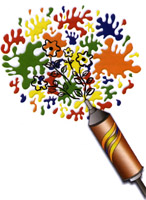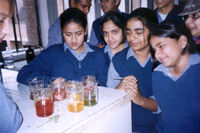|
The Chemical composition of a few Holi colours
and their Health Impacts
|
| Colour |
Composition |
Health Effects |
| Black |
Lead
oxide |
Renal
Failure, Learning disability |
| Green |
Copper
Sulphate |
Eye
allergy, Temporary blindness |
| Purple |
Chromium
iodide |
Bronchial
asthma, Allergies |
| Silver |
Aluminium
Bromide |
Carcinogenic |
| Red |
Mercury
Sulphite |
Skin
cancer, Minamata disease (mental retardation, paralysis, impared
vision...) |
| Source : Vatavaran |
|
 |
|
Ever Greens
Dry
1. Use mehendi / henna powder, separately or mix with equal quantity of any suitable flour to attain a lovely green shade. Use only
pure mehendi and not the one mixed with amla (meant to be applied to our hair)
as this would be brown in colour. Dry mehendi will not leave colour on your face
as it can be easily brushed off. Only when it is a paste (i.e. it is mixed in
water) it will leave a slight colour on your face. Thus, it can be used as a
pucca / fast colour. Many people like smearing other person’s hair with
colours. How about doing it with mehendi powder and saving a trip to the parlour?
2. Dry and finely powder the leaves of Gulmohur (Delonix
regia) tree for a green.
3. Crush the tender leaves of the Wheat plant to obtain a natural safe green
Holi colour.
Wet
1. Mix two teaspoons of mehendi in one litre of water and
stir it well to get a green colour.
2. Green colour can also be obtained by mixing a fine paste
of leaves like spinach / palak, coriander / dhaniya, mint / pudina, etc. in
water.
Sunny Yellows
Dry
1. Mix two teaspoons of haldi / Turmeric powder with double the
quantity of besan (gram flour). Haldi and besan are extremely healthy for our
skin, and are also used widely as a ubtan while taking bath. You can use the
ordinary haldi or "kasturi" haldi which is very fragrant and has
enhanced therapeutic effects. Besan can be substituted by atta, maida, rice
flour, arrowroot powder, fuller’s earth / multani mitti and even talcum powder.
2. Flowers like Amaltas (Cassia fistula), Marigold /
Gainda (Tagetus erecta), Yellow Chrysanthemums, Black Babul (Acacia
arabica) yield different shades of yellow. Dry the petals of these flowers in
shade and crush them to obtain a fine powder. Mix appropriate quantity of the
powder with besan, etc. or use separately.
3. Dry the rind of the Bael fruit (Aegle marmelos) and
grind to obtain a yellow coloured powder.
Wet
1. Add one teaspoon of haldi to two litres of water and stir
well. This can be boiled to increase the concentration of colour and further
diluted.
2. Soak Amaltas (Cassia fistula) or Marigold / Gainda
(Tagetus erecta) flowers in water. Boil and leave overnight.
Resplendent Reds
Dry
1. Red Sandal Wood Powder / Raktachandan / Lalchandan (Pterocarpus
santalinus) has a beautiful red colour and is extremely beneficial for the
skin and is used in face packs, etc. This can be used instead of Red Gulal.
2. Dry red hibiscus flowers in shade and grind it to make a
lovely red colour. To increase the bulk add any flour to it.
3. Sinduria, called Annato in English has a water chestnut
shaped fruit which contains lovely brick red coloured seeds. These yield both
dry and wet colours.
Wet
1. Put two teaspoons of Red Sandal wood powder in a litre of
water and boil. Dilute and use.
2. Peels of Red Pomegranate boiled in water give red.

3. For a bright orangish-red, mix thoroughly a pinch of chuna
/ lime powder (the one that we eat with our paan / betel leaves) with 2 spoons
of haldi powder and a few drops of water. Use only after diluting with 10 litres
of water.
4. Buras (Rhododendron arboreum) known as Burans in
the Garhwal hills and Brans in the Kumaon hills gives a lovely red colour when
soaked in water overnight.
5. Red hibiscus flowers soaked in water overnight give a red
which also has medicinal value.
6. The Palita Madar / Pangri / Indian Coral tree/ (Erythrina indica),
found commonly in coastal regions, has large red flowers. Soak the flowers in
water overnight.
7. Boil wood of Madder Tree in water for a deep red.
8. Red colour can also be obtained from juice of tomatoes and
carrots. This can be diluted with sufficient quantity of water to remove the
stickiness.
Beautiful Blues
Dry
1. The Jacaranda flowers can be dried in the shade and ground
to obtain a beautiful blue powder. The flowers bloom in summers.
2. The blue Hibiscus which is found in Kerala can be dried
and powdered just like the red hibiscus
Wet
1. Crush the berries (fruits) of the Indigo plant and add to
water for desired colour strength. In some Indigo species the leaves when boiled
in water yield a rich blue.
Magnificent Magentas
Wet
1. Slice or grate one Beet root. Soak in 1 litre of water for
a wonderful magenta. Boil or leave overnight for a deeper shade.
2. Boil the peels of 10 - 15 pink Onions in half litre of
water for an orangish-pink colour. Remove the peels before using to remove the
smell.
3. Soak Kachnar (Bauhinia variegata) flowers (pink
variety) in water overnight, or boil for a pinkish colour.
Sacred Saffrons
Wet
1. The Flame of the Forest (Butea monosperma), known as Tesu, Palash
or Dhak in vernacular languages, is the source of the wonderful, traditional
colour for Holi. The flowers are soaked overnight in water and can also be
boiled to obtain a fragrant yellowish – orange colored water. The dried
flowers can be dried and powdered for a orange powder. Legend says that Lord Krishna
used to play Holi with Tesu flowers. The flowers also have a lot of medicinal
properties. Tesu blooms during the month of March.
2. Boil flower petals of red variety of Semul / Silk Cotton (Bombax
ceiba ) in water.
3. Collect and dry the stalks of Harashringar / Parijatak (Nyctanthes
arbor-tristis) flowers during the early winter season. Soak them in water to
get a pleasant orange colour.
4. Mix a pinch of Sandalwood powder from Ujjain (also used in
our temples) in 1 litre of water for an instant, beautiful and fragrant saffron
colour.
5. Soak a few stalks of Saffron / Kesar in 2 table spoons of
water. Leave for few hours and grind to make a fine paste. Dilute with water for
desired colour strength. Though expensive, it is excellent for our skin.
Earthy Browns
Wet
1. Kattha (Acacia catechu), the one eaten in pan/beetle
leaves, when mixed with water will give a brownish colour.
2. Boil Tea or Coffee leaves in water. Cool and use.
Back To Blacks
Wet
1. Boil dried fruits of Amla / Indian Gooseberry in an iron
vessel and leave overnight. Dilute with water and use.
2. Extract juice of black grapes and dilute with sufficient
quantity of water to remove stickiness.
|
ENVIRONMENT
I Love the flowers
they teach me how to sing and smile.
I Love the trees
they make the environment clean.
I Love the birds
they teach me how to hop and chirp.
I Love the hills
they teach me how to stand straight.
I Love the soil
they teach me how to grow plants.
Madhur, VI A, Montfort School, Delhi
|
|
|

